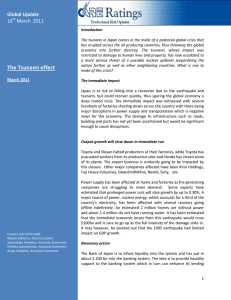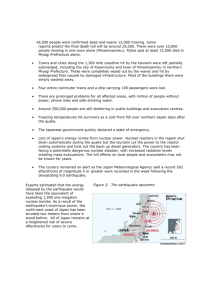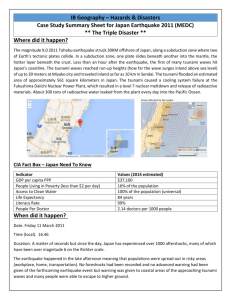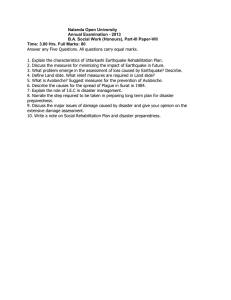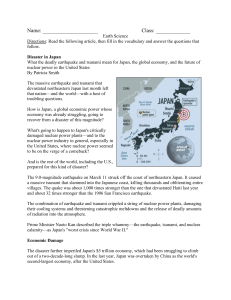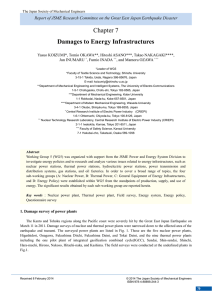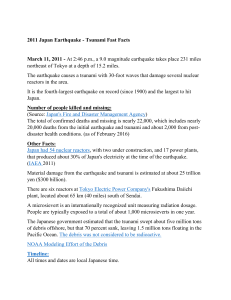High Level Forum on Official Statistics
advertisement
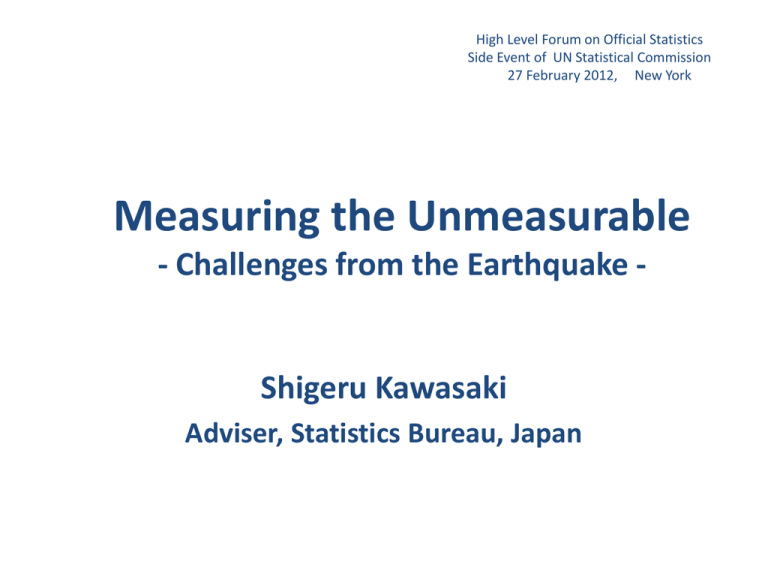
High Level Forum on Official Statistics Side Event of UN Statistical Commission 27 February 2012, New York Measuring the Unmeasurable - Challenges from the Earthquake - Shigeru Kawasaki Adviser, Statistics Bureau, Japan 1 Introduction • What does it take to “measure”? - define the concepts, scales, units. - design the methods for data collection. - implement data collection & estimation. • Why look at the earthquake? - Under extreme conditions, limits and weaknesses in current statistics will emerge clearly. - Disasters may happen to any country. • Challenges are found in measuring - the change in population - the impact on energy & environment - the impact on economy & public finance 2012/2/27 2 2 The 2011 Earthquake in Eastern Japan A massive earthquake of M 9.0 struck eastern Japan at 14:46 on 11 March 2011. Together with tsunami and the accident in the nuclear power plant, enormous damage was inflicted on the people and the area. Dead: Missing: Relocated: Destroyed: Flooded area: 15,852 persons 3,287 persons 342,509 persons 120,204 dwellings 561 km2 cf. Total population 128 million Total area 377,950 km2 2012/2/27 Intensity + + - Epicenter 0 100 200 300 400 km 3 3 Measuring the Change in Population • To provide rescue and relief effectively, data on the population affected by the disaster were needed quickly. • Direct data collection in the disaster area was not possible. -----> To obtain indirect estimates on small-area basis, statistics were combined with geographic information from aerial photos. Customized statistical maps were provided to local authorities. • For reconstruction planning, migration data of the people in the area was needed, in addition to socio-economic statistics. • People moving out were hesitant to register new addresses. -----> Registration was encouraged by giving special treatment for disaster area (retain the old one while reporting the new one) The new national ID system planned for launch in 2015 will help improve population and migration statistics. 2012/2/27 4 Base Map of Tsunami flooded areas (Sample) 2012/2/27 5 4 Assessing the Impact on Energy & Environment • The accident at the nuclear plant caused electricity shortage. Quota was introduced as immediate measure, but the plan was very rough due to lack of data. • Reliance on the nuclear energy is under review. Direction of future energy balance is likely to change drastically. -----> More detailed data on energy is needed, e.g. - Hourly pattern of electricity consumption - Cost comparison of different energy sources - Environmental load of different energy sources - Information on the new energy sources (Data are mainly with private sector or policy makers -----> Necessary to include data providers and policy makers as players of official statistics) The “smart-grid” electricity network will be a valuable data source for energy & environment and the economy. 2012/2/27 6 5-1 Assessing the economic impact and risks • For reconstruction in 2011-2021, 23 trillion yen budget (approx. US$ 288 billion) will be allocated, excluding the cost related to the nuclear accident. • The spending will increase the public debt to the world highest level in the ratio to GDP. General government net financial liabilities • Additional cost for (% of GDP) the nuclear accident 160 % Greece has to be assessed 140 120 properly. Japan 100 • The risk of instability USA of the economy will 80 60 France become higher. 40 Germany Careful monitoring 20 of economy & finance 0 will be necessary. 2012/2/27 Source: OECE Economic Outlook No.90 7 5-2 Assessing the economic impact and risks As the global financial crisis, first by the subprime mortgage loans in the summer of 2007, followed by the sovereign debt in 2010, continues, the economy is becoming more unforeseeable than before just by observing the economy of just one country. 10 % 8 Real GDP Growth, Year-on-Year Emerging Economies 6 Exchange Rates (Euro and US$ to JPY) World 4 2 -6 Source: IMF WEO Database Sept 2011 2012/2/27 2011Q1 2010Q1 2009Q1 2008Q1 2007Q1 2006Q1 2005Q1 2004Q1 2003Q1 2002Q1 -4 2001Q1 -2 2000Q1 0 Advanced Economies 180 170 160 150 140 130 120 110 100 90 80 70 60 Yen / Euro Yen / US $ 2000 2002 2004 2006 Source: OECD MEI Database 2008 2010 8 6 Conclusion • Challenges from the earthquake include: - To enhance the value of statistics by more use of GIS. - To assure timeliness and accuracy of civil registration - To improve data collection of energy & environment to promote more informed public debate and decision-making - To assess the full recovery cost including nuclear power - To monitor economy and finance to maintain stable economic growth and minimize the risk of instability • More collaboration with policy makers and data providers (or their inclusion into official statistics) will be necessary • The challenges are generally in line with the current direction of international official statistics. International collaboration is essential. • Sharing different experiences among countries is essential. 2012/2/27 9 The End Thank you! 2012/2/27 10
